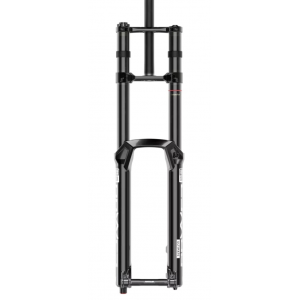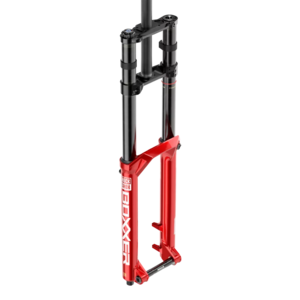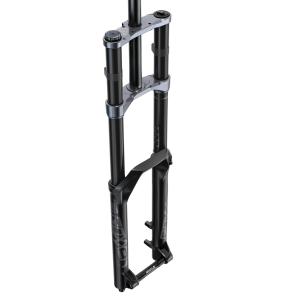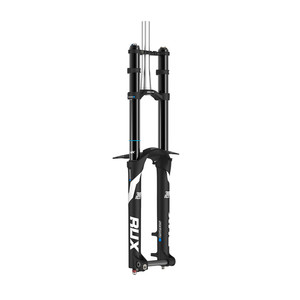RockShox BoXXer World Cup Fork with Charger Damper
(discontinued)
| Where To Buy | |||
|---|---|---|---|
Free shipping on orders over $50 (continental U.S. only).
International shipping available. Some exclusions apply. |
Free shipping on orders over $50 (continental U.S. only).
International shipping available. Some exclusions apply. $1,899.00
|
||
Free shipping on orders over $50 (continental U.S. only).
International shipping available. Some exclusions apply. |
|||
Review by Sven Martin // Photos by Adrian Marcoux, Sven Martin, and SRAM
When you saw the recent SRAM X01DH drivetrain feature, you might have wondered why SRAM would fly a bunch of journalists from all around the world to New Zealand just to sample a few less gears. As successful as that launch went, you’re right, it wasn’t just about gears and Queenstown beers… We also came to sample something else - something more than just refinement and product extension, something more like cheating.
While not entirely new to the eyes (it was on a number of 2013 World Cup and Rampage bikes), this was the first time riders other than the elite Blackbox crew could experience the brand new RockShox BoXXer with the Charger Damper.

2015 BoXXer Fork Highlights
- Models: World Cup, Team, and RC
- Wheel Sizes: 26 or 27.5-inches
- Travel: 7.9-inches (200mm)
- Compression Damper: Charger (World Cup and Team) or Motion Control IS (RC)
- Rebound Damper: Rapid Recovery
- External Adjustments: Beginning stroke rebound, low-speed compression, and air pressure
- Internal Adjustments: High-speed compression, high-speed rebound, and air volume via Bottomless Tokens (World Cup)
- Spring: Solo Air (World Cup) or Coil (Team and RC)
- Stanchions: Fast Black 35mm aluminum
- Axle: 20mm Maxle Lite DH
- Colors: Black, White, and Diffusion Black with aftermarket sticker kit available for customization
- Weight: 26” - 2,585g, 27.5” - 2,637g (World Cup) // 2,890g, 2,942g (Team) // 2,882g, 2,934g (RC)
- MSRP: 26” - $1,700, 27.5” - $1,735 (World Cup) // $1,275, $1,310 (Team) // $865, $900 (RC)
- Availability: August 2014
While I don’t ride and race as much downhill as I used to, it’s still my number one passion. Downhill is mountain biking's F1, and it’s what keeps me glued to the side of the best DH tracks in the world observing the best racers year in and year out. I spend enough time trackside to put every tiny piece of the downhill racing puzzle under the microscope. I notice bike setup, tire choice, line choice, style, technique, mental fortitude, and the all important suspension performance (I also take photos sometimes too).
Traveling with the circus over the years, I’ve had the opportunity to ride a lot of the actual World Cup and even World Championship podium bikes on the tracks they have just performed on. Besides the obvious stiffer setups the top racers prefer (that often felt perfect for me), their suspension, particularly the front, always felt better than any of my own personal bikes no matter how much love and service I or any suspension specialists gave them. This always seemed like a case of constant custom tuning, special prototype parts, expensive low friction seals, fluids, and new technology not yet available to the public. I’m not just talking RockShox suspension here - I’m talking across the board.

With the introduction of the 2015 BoXXer with the Charger Damper, those days are over. World Cup Pro level suspension will be available to the public soon. In fact, the suspension on the test bike I was privileged to ride felt BETTER than any top Pro’s bike I have ridden in recent years.
That claim may seem a bit bold, and I can understand you may think I drank too much of the red Kool-Aid (NZ micro brewery beer) amply provided by SRAM and RockShox in beautiful Queenstown, New Zealand, but hear me out. I’ve always kept my bikes updated, not necessarily a new frame every year, but as a bit of a bike geek I make sure I have the most up to date suspension. As a result I have ridden every model year BoXXer fork over the last ten plus year period, and more than a few competing brands too. Over this time there have been various small improvements to the BoXXer - sometimes to the chassis, seals, and bushings, sometimes tweaking existing internals… constant incremental advances and improvements have been made right up until the current model year. Today that that all changes, and RockShox has made a monumental leap ahead compared to all those small changes over the years combined.
What’s New?
- Charger Damper with Rapid Recovery rebound (World Cup and Team)
- Air and coil spring refinements (World Cup and Team)
- Fast Black upper tubes (all models)
- 27.5-inch option (all models)
- 131 gram weight reduction (World Cup)
- Fewer external adjustments
BoXXer Development
Listen in as Jeremiah Boobar, a RockShox Product Manager, discusses the development process with the help of his team of engineers, test riders, and Blackbox athletes:
Charger Damper
Unless you’ve been living under a rock, you’ve very likely seen the Charger Damper before. It’s one of the big reasons why the RockShox Pike trail/all-mountain fork is so well regarded. Why start with a trail fork and then move to downhill? The concept of the damper started as a downhill development in 2011, but after seeing a huge opportunity in the trail market, the Pike was the first to receive it.
The sealed cartridge Charger Damper design uses an extruded bladder filled with 3-weight oil that expands to contain the oil displaced by the fork as it moves through its travel.This design helps keep damping consistent by ensuring that no air mixes with the oil, even during rough descents. A fully bled system has no air in it, directing more of the compression force through the damping circuit and less into the spring. Compared to fork’s using a traditional IFP system, much less pressure is needed to get the fork moving, resulting in superb compliance. Just like the Pike, the service interval for the BoXXer’s Charger Damper is approximately 200 hours and the bleed process can be done in less than 5 minutes.
Most of the weight loss (~100 grams) on the new BoXXer was due to the damper swap. The rest comes from removing external adjusters from the spring sides. Gone are high-speed rebound and high-speed compression, but know that it’s still possible to disassemble the damper and rearrange the shims for a softer or firmer tune. Changing the tunes in the Charger is an advanced procedure, and with the right tools and a good work area it will take 30 minutes to 2 hours, depending on experience.

Solo Air Spring Updates
The Solo Air version found on the World Cup model features a revised spring curve and the possibility to tune the spring’s progression with Bottomless Tokens, shown in red below. The fork comes stock with one Token installed. Aggressive and heavy riders will likely want to add a Token or two. Most World Cup racers are using three Tokens, but it's best to try the fork and build up progression based on your needs.
SoloAir automatically adjusts both positive and negative pressures for any rider weight. The coil sprung Team BoXXer receives a new, factory set bottom out progression.

27.5 Options
It’s no longer much of a secret that 27.5-inch wheels are being used on many of the top racer’s downhill bikes, and production 27.5 DH rigs are popping up left and right. Of course RockShox is ready to meet the demand, and we first saw hints of this at the 2013 DH World Championships in South Africa. A 27.5-inch version is available for all BoXXer models, as well as the more affordable Domain fork.
The 27.5-inch versions see the addition of new lowers only. It’s possible to convert 26-inch BoXXers by purchasing new lower legs. 6mm of offset was added to the 26-inch dropouts, bringing it out to 48mm to provide comparable handling when combined with the new wheel size, axle to crown height, and frame geometry.
On The Trail
Having rushed to New Zealand straight from some #enduro racing and exploring in Chile, I missed an opportunity to ride a perfectly tuned 2013 RockShox BoXXer WC fork then switch over to the new Charger Damper while keeping everything else on the bike the same. Luckily my personal downhill bike has the 2013 BoXXer World Cup on it, and having just ridden in Queenstown a few weeks prior I knew exactly how it felt for comparison’s sake. Off I went on my first run on a Devinci Wilson Carbon with the new X01DH drivetrain and the new Charger Damper equipped BoXXer.

Thanks to an on-going dry summer and high number of Whistlerites, Brits, and Frenchies living abroad as seasonaires in Queenstown, I dropped into a trail that looked even rougher than last time I had ridden. Almost immediately I had to pull off to the side of the trail as something felt wrong. Or was it?
I expected a certain amount of ground feedback from the fork, but I felt absolutely nothing from the front end. It had to be set up wrong I thought. Perhaps it leaked some air or I had too much sag… Something had to have gone wrong despite my anal setup with a digital shock gauge. Nope, all was good. The little travel indicator ring on the stanchion showed I was still sitting high up in my travel since I hadn’t hit anything big yet. Weird. So I set off again for a bit longer.

Still, the front end had a remarkably quiet, smooth feeling with no kickback - just a soft, effortless ride. Not sure about what was happening, I took it easy and didn’t push too hard. After a few turns I had to pull over again, not convinced that something wasn’t amiss. It felt too smooth. Perhaps my front tire pressure on the Magic Mary’s was too low… I’m kind of OCD with some things like tire pressure, and for that reason I carry a digital tire gauge with me all the time. So I did a quick tire check and that too was spot on.
And then it hit me. WOW! All these things I was experiencing - the smooth feeling, ground absorption, and magic traction was having me think something was wrong, that it was too good to be true and I had everything set too soft. Far from it. Now, finally confident that it was all correct and gaining confidence on the Devinci that I was now getting used to, I was able to open it up a lot more on the next several runs.

After bringing my speed up to race pace (my race pace at least), there was no fall off in feel or performance at all. What’s more, I was able to ride and hang on with no early onset of arm pump or hand fatigue that my unfit self suffers from these days. I immediately felt fitter and stronger, which I’m neither of, not realizing before how much of my hand and arm fatigue was induced by suspension reaction.
Now forgive me for sounding like I’m exaggerating here (I’d be suspect if I was reading this too), but I’m honestly not. In a few short runs I was riding better than I had in ages. The physical benefits were one thing (lack of fatigue, etc), but the increased traction from the front end I was experiencing allowed me to hit the corners faster and with more confidence. I developed a subliminal feeling of front-end awareness, trusting that that the front wouldn’t wash or kick back from any obstacles. This confidence allowed me to not only lean over more, but also take my foot off less. I could corner more like I visualized myself cornering - like what I see at World Cups from much more skilled racers than myself.
This all equated to more speed. Instantly. All without doing anything at all.
I basically forgot about the front end completely. It became consistent and intuitive which allowed me to look further down the trail and plan my braking and line choice better. I stopped worrying about finding the smoothest way through corners and sections as this didn’t seem to be as big of a concern anymore. When realistically feasible, I’d just take the most direct line without fear of consequence.

The glued-to-the-ground feel did have a drawback though, and I was feeling a little speed being robbed by not being able to push off the turns with the suspension and catapult out. So I chatted to Jeremiah Boobar about this. He suggested I try out the fork with another Bottomless Token. At the time my fork had a single token in it. It was a quick and easy add another. I’m a bit heavier than most, and by now was up to speed, pushing the fork a lot harder, and wanted to feel that positive push back, especially when trying to generate speed or pop out of corners. With the extra Token installed it was now noticeably better in this regard.
While some of the external adjustments have been taken away on this new fork, it seemed that I didn’t need it. The stock high-speed compression and rebound settings inside the damper felt spot on. Externally you can still change air pressure and low-speed (beginning stroke) rebound and compression.
But Wait, There’s More… Upgrade Kits
Over beers and good food later that night, I chatted with the marketing and product managers, telling them that after the success of the much embraced Pike which also contains the Charger Damper, they are on to a goldmine here. Once the word spreads people will be dumping their old forks left and right with no choice but to upgrade to the new one, and they stood to really sell a ton of forks. They surprised me with the news that they are also offering of an upgrade kit.
The new Charger Damper will be available at a modest price of $379 to any 2010 and newer BoXXer owner, so there’s no need to buy a new fork if your’s falls in this range. If you have a mid-2011 fork and later, you can also install the new Solo Air Spring that is tunable with the Bottomless Tokens for $188. This news wasn’t something I expected from a big company with a new complete product up for sale. Good on them.
The Charger Damper upgrade is very easy, requiring less than an hour of time. The Solo Air Spring upgrade will take an additional hour or less, and both procedures make use of readily available tools.

What’s The Bottom Line?
To be honest, riding the new RockShox BoXXer fork felt like cheating. It was like giving a racer a bunch of free seconds. “Here’s a new fork and 5 seconds off your next run. How do you like that?” Coupled with the mental and physical gains I experienced, the performance of the fork was nothing short of outstanding. So, game changing? Yes. Provided it holds up in the long term, this fork is more than deserving of a 5-star rating.
Not to take anything away from Stevie Smith’s performance last year, but when it was so close all season long, there’s no doubt in my mind that this new Charger Damper helped. It had to. Seeing Hart, Neethling, Hill, Bruni, Blenkinsop, and Ragot on the podium too just further backs it up. This whole experience makes one wonder what the Blackbox riders will be on this year, as I cant imagine something better than this.
Like I mentioned before, the addition of the Charger Damper is not just a minor incremental improvement, but a massive one.
Availability
Charger Damper and Solo Air upgrade kits will be available in June 2014, and the new BoXXer models will follow in August. Visit www.rockshox.com for more details.
Specifications
Magnesium lowers
Maxle Lite DH axle
Printed air pressure guide on fork leg
Air spring curve may be tuned by adding or removing Bottomless Tokens
| Where To Buy | |||
|---|---|---|---|
Free shipping on orders over $50 (continental U.S. only).
International shipping available. Some exclusions apply. |
Free shipping on orders over $50 (continental U.S. only).
International shipping available. Some exclusions apply. $1,899.00
|
||
Free shipping on orders over $50 (continental U.S. only).
International shipping available. Some exclusions apply. |
|||






























9 comments
Post a reply to: First Ride: RockShox BoXXer with Charger Damper